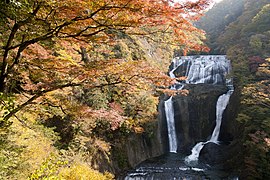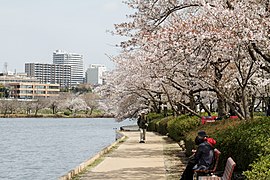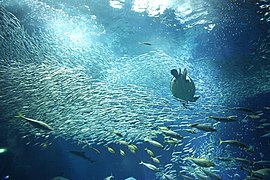Ibaraki Prefecture
You can helpexpand this article with text translated fromthe corresponding articlein Japanese.(December 2016)Click [show] for important translation instructions.
|
Ibaraki Prefecture
Tì thành huyện | |
|---|---|
| Japanese transcription(s) | |
| •Japanese | Tì thành huyện |
| •Rōmaji | Ibaraki-ken |
| Anthem:Ibaraki kenmin no uta | |
 | |
| Country | |
| Island | Honshu |
| Region | Kantō |
| Prefecture | Ibaraki |
| Capital | Mito |
| Subdivisions | Districts:7,Municipalities:44 |
| Government | |
| •Governor | Kazuhiko Ōigawa |
| Area | |
| • Total | 6,097.19 km2(2,354.14 sq mi) |
| • Rank | 24th |
| Population (July 1, 2023) | |
| • Total | 2,828,086 |
| • Rank | 11th |
| • Density | 460/km2(1,200/sq mi) |
| • Dialect | Ibaraki dialect |
| GDP | |
| • Total | JP¥14,092 billion US$129.3 billion (2019) |
| ISO 3166 code | JP-08 |
| Website | www |
| Symbols of Ibaraki Prefecture | |
| Bird | EurasianSkylark(Alauda arvensis) |
| Flower | Rose(Rosa) |
| Tree | Umetree (Prunus mume) |

Ibaraki Prefecture(Tì thành huyện,Ibaraki-ken)is aprefectureofJapanlocated in theKantō regionofHonshu.[3]Ibaraki Prefecture has a population of 2,828,086 (1 July 2023) and has a geographic area of 6,097.19 square kilometres (2,354.14 square miles). Ibaraki Prefecture bordersFukushima Prefectureto the north,Tochigi Prefectureto the northwest,Saitama Prefectureto the southwest,Chiba Prefectureto the south, and thePacific Oceanto the east.
Mito,the capital, is the largest city in Ibaraki Prefecture. Other major cities includeTsukuba,Hitachi,andHitachinaka.[4]Ibaraki Prefecture is located on Japan's easternPacificcoast to the northeast ofTokyo,and is part of theGreater Tokyo Area,the most populousmetropolitan areain the world. Ibaraki Prefecture featuresLake Kasumigaura,the second-largest lake in Japan; theTone River,Japan's second-longest river and largestdrainage basin;andMount Tsukuba,one of the most famous mountains in Japan. Ibaraki Prefecture is also home toKairaku-en,one of theThree Great Gardens of Japan,and is an important center for themartial artofAikido.
History
[edit]This sectionneeds expansion.You can help byadding to it.(June 2008) |
Ibaraki Prefecture was previously known asHitachi Province.In 1871, the name of the province became Ibaraki, and in 1875 it became its current size, by annexing some districts belonging to the extinctShimōsa Province.

Paleolithic
[edit]InJapanese Paleolithic,humans are believed to have started living in the present-day prefecture area before and after the deposition of the volcanic ash layer from theAira Calderaabout 24,000 years ago. At the bottom of this layer are local tools of polished stone and burnt pebbles.
Asuka period
[edit]During theAsuka periodthe provinces of Hitachi andFusawere created. Later Fusa was divided, among them, the Shimōsa Province.
Muromachi period
[edit]At the beginning of theMuromachi period,in the 14th century,Kitabatake Chikafusamade of theOda Castlehis field headquarters for over a year, and wrote theJinnō Shōtōki(Chronicles of the Authentic Lineages of the Divine Emperors), while he was at castle.
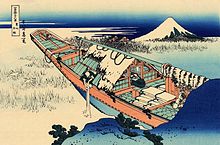
Edo period
[edit]During theEdo period,one of the three houses or clans originating fromTokugawa Ieyasu(Gosanke ngự tam gia, three houses), settled in theMito Domain,the clan is known as theMito Tokugawa familyor simply the Mito clan. Mito Domain, was a Japanese domain of the Edo-periodHitachi Province.
In 1657, aMitogakuwas created whenTokugawa Mitsukuni,head of the Mito Domain, commissioned the compilation of theDai Nihonshi,a book on the history of Japan.
Meiji period
[edit]InMeiji era,during theMeiji Restoration,the political map changes, the old provinces are converted or merged, to create the current prefectures, in this case the Ibaraki Prefecture.
Geography
[edit]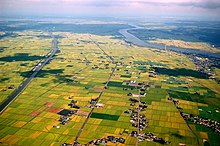

CityTownVillageLake

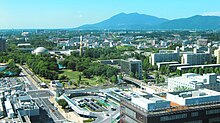



Ibaraki Prefecture is the northeastern part of theKantō region,stretching betweenTochigi Prefectureand thePacific Oceanand bounded on the north and south byFukushima PrefectureandChiba Prefecture.It also has a border on the southwest withSaitama Prefecture.The northernmost part of the prefecture is mountainous, but most of the prefecture is a flat plain with many lakes and is part ofKantō Plain.
Natural parks
[edit]As of 1 April 2012[update],15% of the total land area of the prefecture was designated asNatural Parks,namelySuigo-Tsukuba Quasi-National Park,and nine Prefectural Natural Parks.[5]Also, Ibaraki has one Prefectural Geopark. The Suigo-Tsukuba Quasi-National Park, also includes the northeast area of Chiba Prefecture.
Mountains
[edit]The northern third of the prefecture is mountainous and in the center is the Tsukuba Mountains ( trúc ba sơn địa ). Its main mountains are:mount Yamizowith an elevation of 1022 m on the border with Fukushima and Tochigi prefectures (tripoint), mount Takasasa with 922 m,mount Tsukubawith two peaks Nyotai-San at 877 m and Nantai-San at 871 m, mount Osho at 804 m, mount Hanazono at 798 m, andmount Kabaat 709 m.
Water system
[edit]The main rivers that flow through the prefecture include theTone,Naka (Ibaraki),andKujirivers, all of which flow into thePacific Ocean.Before the seventeenth century, the lower reaches of the Tone were different from its current layout, and the Tone ran south and emptied intoTokyo Bay,and tributaries such as the Watarase and Kinu rivers had independent water systems.
The main tributaries of the Tone River basin are theKinu Riverand Kokai River, which flow from north to south in the western part of the prefecture. The Shintone and Sakura rivers flow into Lake Nishiura.
TheEdo Riverflows into Tokyo Bay; its source currently rises as an arm of the Tone River. In the past, the course of the Edo River was different, its source was corrected and diverted to the Tone River in the 17th century by the Tokugawa shogunate to protect the city ofEdo(now Tokyo) from flooding.
The Tone River, in addition to the Edo River, is part of the southern border of Ibaraki Prefecture with Chiba Prefecture, and theWatarase River,Tone River, Gongendō River, andNaka River (Saitama)in the southwestern border of Ibaraki with Saitama Prefecture. The Watarase River has become a small boundary of the southern border between Ibaraki and Tochigi prefectures.
From ancient times to the beginning of the Edo period, the lower reaches of the Tone River did not exist and the mouth of the Tone was in Tokyo Bay. On the plain was theKatori Sea,which existed in ancient times,[6]theLake Kasumigauraand other lagoons in present-day Chiba prefecture are remnants of that sea. Katori Sea was connected to the Kashima-nada (Pacific Ocean).
Lake Kasumigaura is currently divided into three lakes: Nishiura, Kitaura, Sotonasakaura. In addition, in the prefecture there are freshwater lagoons such as Hinuma,Senba,and Ushiku.
Fukuoka Dam,is a dam that spans the Kokai River inTsukubamirai,it is one of the three largest dams in the Kantō region. Ryūjin Dam inHitachiōta,is a beautiful dam on the Ryūjin River with a large pedestrian suspension bridge above the dam lake.
Cities
[edit]Thirty-two (32) cities are located in Ibaraki Prefecture:
- Mito(capital city of the prefecture)
- Bandō
- Chikusei
- Hitachi
- Hitachinaka
- Hitachiōmiya
- Hitachiōta
- Hokota
- Inashiki
- Ishioka
- Itako
- Jōsō
- Kamisu
- Kasama
- Kashima
- Kasumigaura
- Kitaibaraki
- Koga
- Moriya
- Naka
- Namegata
- Omitama
- Ryūgasaki
- Sakuragawa
- Shimotsuma
- Takahagi
- Toride
- Tsuchiura
- Tsukuba
- Tsukubamirai
- Ushiku
- Yūki
Towns and villages
[edit]These are the towns and villages in eachdistrict,10 towns and 2 villages in 7 districts:
Mergers
[edit]Economy
[edit]Ibaraki's economy is based on energy production (particularly nuclear energy), chemical and precision machining industries, research institutes, and tourism. Agriculture, fishing, and livestock are also important sectors in the prefecture.[7]
Ibaraki's vast flat terrain make it highly suitable for industrial development. This complements its proximity to the Tokyo metropolitan area, giving it a high reputation as an industrial base. The prefecture is also home toTsukuba,Japan's most extensive research and academic city, and the birthplace ofHitachi,Ltd.[8]


Agriculture
[edit]With extensive flat lands, abundant water, and suitable climate, Ibaraki is among the prefectures with the highest agricultural production in Japan. It plays an important role in supplying food to the Tokyo metropolitan area. Its main products include melons, pears, peppers, various varieties of rice and sugar cane, as well as flowers and ornamental plants.
It also supplies other food crops to the rest of the country. As of March 2011, the prefecture produced 25% of Japan's bell peppers and Chinese cabbage.[9]
Fishing
[edit]It is one of the prefectures with the highest fish production in the country; in the Pacific Ocean, Lake Kasumigaura, other lagoons and rivers, various species of fish are obtained.
Cattle
[edit]The Hitachigyū cattle ( thường lục ngưu - ひたちぎゅう - Hitachi-gyū, Hitachi-ushi), which is a prefectural bovine breed, is noteworthy in livestock. The name comes from the kanji thường lục (Hitachi), the name of the ancient Hitachi Province and ngưu (ushi or gyū, beef).[10]
Background. In 1833 Tokugawa Nariaki ( đức xuyên 斉 chiêu ) established the breeding of black cattle in the present Migawa-chō ( kiến xuyên đinh ) of the city of Mito. Originally it remained mainly in the northern part of the prefecture, but later it spread throughout the prefecture.
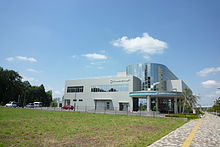
Industrial centers
[edit]- Hitachi area. Grouping of industries, such as electrical, electronic and machinery. More than 1,300 companies; many of them hired by theHitachicompany, which was founded in Sukegawa (HitachiCity) in 1910.
- Tōkai area. Atomic Energy Research Organization Grouping.J-PARC,Proton Accelerator Research Complex.
- Tsukuba area. 32 institutes for education and research. Manipulation of matter at the level of atoms (nanotechnology). Robotic security center for support in daily life. Space center.
- Kashima area. Grouping of materials industries, such as steel and petrochemicals, around 160 companies.
Demographics
[edit]
| Year | Pop. | ±% p.a. |
|---|---|---|
| 1890 | 1,025,497 | — |
| 1903 | 1,200,475 | +1.22% |
| 1913 | 1,328,329 | +1.02% |
| 1920 | 1,350,400 | +0.24% |
| 1925 | 1,409,092 | +0.85% |
| 1930 | 1,487,097 | +1.08% |
| 1935 | 1,548,991 | +0.82% |
| 1940 | 1,620,000 | +0.90% |
| 1945 | 1,944,344 | +3.72% |
| 1950 | 2,039,418 | +0.96% |
| 1955 | 2,064,037 | +0.24% |
| 1960 | 2,047,024 | −0.17% |
| 1965 | 2,056,154 | +0.09% |
| 1970 | 2,143,551 | +0.84% |
| 1975 | 2,342,198 | +1.79% |
| 1980 | 2,558,007 | +1.78% |
| 1985 | 2,725,005 | +1.27% |
| 1990 | 2,845,382 | +0.87% |
| 1995 | 2,955,530 | +0.76% |
| 2000 | 2,985,676 | +0.20% |
| 2005 | 2,975,167 | −0.07% |
| 2010 | 2,969,770 | −0.04% |
| 2015 | 2,917,857 | −0.35% |
| 2020 | 2,854,131 | −0.44% |
| source:[11] | ||
Ibaraki's population is decreasing more rapidly than any other prefecture.[12][13]
Culture
[edit]Ibaraki is known fornattō,or fermented soybeans, inMito,watermelons inKyōwa(recently merged intoChikusei), andchestnutsin theNishiibarakiregion.[14]
Ibaraki is famous for the martial art ofAikidofounded byMorihei Ueshiba,also known asOsensei.Ueshiba spent the latter part of his life in the town ofIwama,now part ofKasama,and theAiki Shrineanddojohe created still remain.[15]
Kasama is famous forShinto(Kasama Inari Shrine), Ibaraki Ceramic Art Museum, house museum of the calligrapher and ceramistKitaōji Rosanjin,Kasama Nichidō Museum of Art,residence ofMorihei Ueshiba,founder of the martial art Aikidō.[16]
The capitalMitois home toKairakuen,one of Japan's three most celebrated gardens, and famous for its over 3,000Japanese plumtrees of over 100 varieties.
Kashima Shrine(Jingū) Ibaraki's cultural heritage.
Mito Tōshō-gū,is the memorial shrine ofTokugawa Ieyasuin Mito.
Seizansōwas the retirement villa ofTokugawa Mitsukuni.
Mito Municipal Botanical Park,is a botanical garden in Mito.
Park Ibaraki Nature Museum inBandō.
There are castle ruins in many cities, includingMito Castle,Yūki Castle,Kasama Castle,Tsuchiura Castle,Oda Castle.
Hitachi Fūryūmono,a puppet float theater festival, Intangible Cultural Heritage of Humanity.
Makabe Hina Doll Festival -Hinamatsuri- (Sakuragawa City).
Yūki-tsumugi(silk weaving technique) Intangible Cultural Heritage of Humanity,Kasama ware,Makabe Stone Lamp, Kagami Crystal Glass Factory, old glass factory in Ryūgasaki City.
Education
[edit]University
[edit]
- Mito
- Ryūgasaki
- Toride
- Tsuchiura
- Tsukuba
Sports
[edit]The sports teams listed below are based in Ibaraki.


Association football
[edit]Volleyball
[edit]- Hitachi Rivale(Women's) (Hitachinaka)
Rugby
[edit]- Stags - Kashima Rugby Football Club RFC (Kashima)
American football
[edit]- Tsukuba University (Tsukuba)
Baseball
[edit]- Ibaraki Astro Planets (Yūki) (Baseball Challenge League)
- Ibaraki Golden Golds (Regional club) (Tsukuba)
Wrestling
[edit]- Hitachi Pro Wrestling (Regional group) (Hitachi)
Basketball
[edit]- Ibaraki Robots(Mito)
Motorsport
[edit]Tourism
[edit]- Fukuroda Falls
- Hitachi Seaside Park
- Ibaraki Prefectural Museum of History
- Kairaku-en (garden)
- Kashima Shrine
- Lake Kasumigaura
- Mount Tsukuba
- Ōarai Aquarium
- Tsukuba Science City
- Ushiku Daibutsu
-
Hobikibune (Sailboat) on Lake Kasumigaura
-
Fukuroda Fallsin Daigo
-
A view of Mount Tsukuba, from Tsukuba City
-
A view of SuigōItakoIris Garden
-
A view ofRokkakudōand Pacific Ocean in Kitaibaraki
-
Nemophila in spring inHitachi Seaside Park
Transportation and access
[edit]

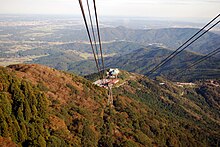
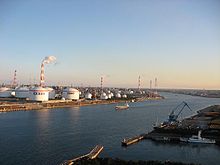

Railways
[edit]- East Japan Railway Company
- Hitachinaka Seaside Railway
- Kantō Railway
- Kashima Rinkai Railway
- Metropolitan Intercity Railway Company
- Mooka Railway
Cable cars
[edit]- Tsukuba Kankō Railway
Bus
[edit]Roads
[edit]Expressways
[edit]National highways
[edit]![]() Ibaraki Prefecture with the following national routes:
Ibaraki Prefecture with the following national routes:
- National Route 4(aroundKogaarea)
- National Route 6(NihonbashiofTokyo-Toride-Tsuchiura-Mito-Hitachi-Iwaki-Sendai)
- National Route 50
- National Route 51(Mito-Kashima-Itako-Narita-Chiba)
- National Route 118
- National Route 123
- National Route 124
- National Route 125(Katori-Tsuchiura-Tsukuba-Koga-Gyōda-Kumagaya)
- National Route 245
- National Route 293
- National Route 294
- National Route 349
- National Route 354
- National Route 355
- National Route 400(Mito-Nakagawa-Nikko-Minamiaizu-Nishiaizu
- National Route 408
- National Route 461
Prefectural routes
[edit]![]() Ibaraki Prefecture with more than 300 prefectural routes.
Ibaraki Prefecture with more than 300 prefectural routes.
Ports
[edit]Airports
[edit]- Ibaraki Airport
- Ōtone AirstripĐại lợi căn phi hành tràng(おおとねひこうじょう,Ōtone Hikōjō)is an airfield located on the Tone River inKawachi.
- Ryūgasaki Airfield
- Tsukuba Heliport
Pronunciation
[edit]The prefecture is often alternatively pronounced "Ibaragi"by those who speak the regional dialect known as Ibaraki-ben. However, the standard pronunciation is "Ibaraki".According to the author of "Not Ibaragi,Ibaraki",[17]this is most likely due to a mishearing of the softening of the "k" sound in Ibaraki dialect.
Sister regions
[edit]Ibaraki is twinned with:
See also
[edit]Notes
[edit]- ^"Natto: Japanese History of a Modern-Day Superfood".NYrture, 2020-01-14.Retrieved2024-09-08.
- ^"2020 niên độ quốc dân kinh tế kế toán ( 2015 niên cơ chuẩn ・2008SNA ): Kinh tế xã hội tổng hợp nghiên cứu sở - nội các phủ".Nội các phủ ホームページ(in Japanese).Retrieved2023-05-18.
- ^Nussbaum, Louis-Frédéric. (2005). "Ibaraki-ken" inJapan Encyclopedia,p. 367, atGoogle Books;"Kantō" inJapan Encyclopedia,p. 479, atGoogle Books.
- ^Nussbaum, "Mito" atJapan Encyclopedia,p. 642, atGoogle Books.
- ^"General overview of area figures for Natural Parks by prefecture"(PDF).Ministry of the Environment.1 April 2012.Archived(PDF)from the original on 21 April 2012.Retrieved9 November2013.
- ^"Ca viên phát tường の địa を phóng ねる “Trúc ba sơn ・ hương thủ の hải” (in Japanese) - To visit the birthplace of Utagaki “Mt. Tsukuba ・ Katori Sea” - ".utakura.com.Archivedfrom the original on October 28, 2021.RetrievedNovember 12,2021.
- ^"About Ibaraki".invest.indus.pref.ibaraki.jp.Archivedfrom the original on November 14, 2021.RetrievedNovember 12,2021.
- ^"data | Attractive Local Regions in Japan - Investing in Japan - Japan External Trade Organization".ジェトロ.Archivedfrom the original on 2022-06-27.Retrieved2022-07-04.
- ^Schreiber, Mark, "Japan's food crisis goes beyond recent panic buyingArchived2011-04-20 at theWayback Machine",The Japan Times,17 April 2011, p. 9.
- ^"Breed info, About Hitachiwagyū Beef".hitachiwagyu.com.Archivedfrom the original on October 22, 2021.RetrievedNovember 12,2021.
- ^"Statistics Bureau of Japan".Archivedfrom the original on 2020-11-08.Retrieved2019-07-21.
- ^"Gov't data show exodus to Tokyo from other parts of Japan continues".Japan Today.1 February 2019. Archived fromthe originalon 3 February 2019.
- ^"Tì thành huyện の nhân khẩu と thế đái ( thôi kế ) - lệnh hòa 2 niên ( 2020 niên ) 12 nguyệt 1 nhật hiện tại - (in Japanese) - Population and households in Ibaraki Prefecture (estimated)-As of December 1, 2020-".pref.ibaraki.jp, December 22, 2020.RetrievedNovember 19,2021.[permanent dead link]
- ^"Ibaraki Guide".ibarakiguide.org.Archivedfrom the original on November 14, 2021.RetrievedNovember 12,2021.
- ^Aikikai Foundation Ibaraki Branch Dojo "[1]Archived2023-06-10 at theWayback MachineFounder and Iwama ", Retrieved August 25, 2017
- ^"Kasamashiko – A Journey Through Japan's Pottery Culture".ibarakiguide.org.Archivedfrom the original on November 14, 2021.RetrievedNovember 12,2021.
- ^いばらぎじゃなくていばらきArchived2017-06-29 at theWayback Machine[Ibaragi ja Nakute Ibaraki]
References
[edit]- Nussbaum, Louis-Frédéric and Käthe Roth. (2005).Japan Encyclopedia.Cambridge:Harvard University Press.ISBN978-0-674-01753-5.OCLC58053128.
External links
[edit]- Ibaraki Prefecture Official Website(in Japanese)
- Ibaraki Prefecture Official Website(in English)














